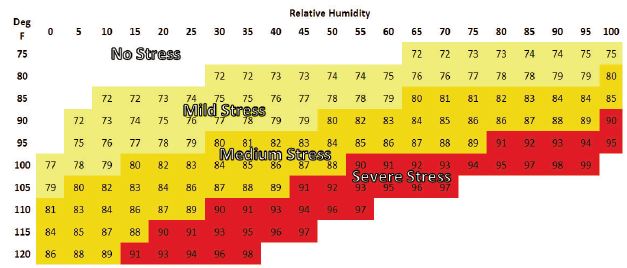



It's Time To Start Thinking About Heat Stress
US - Fertility, yields and feed intake all plummet unless the seasonal threat of heat and humidity can be properly mitigated, says an Arkansas expert.The heat and humidity of a typical Arkansas summer combine to make a very uncomfortable environment for lactating dairy cows, writes Dr Karl VanDevender, extension engineer at the department of biological and agricultural.
During hot summer weather, milk production may decrease by as much as 50 per cent and reproductive proficiency of lactating dairy cows is greatly diminished.
Some data indicate that only 10 to 20 per cent of inseminations in “heat stressed” cows result in pregnancies.
Some signs of heat stress in lactating cows are obvious, especially the reduced milk production and the lethargic behavior of the cows.
Moderate signs of heat stress may occur when the temperature is between 80° and 90°F with the humidity ranging from 50 to 90 per cent These signs include rapid shallow breathing, profuse sweating and an approximately 10 per cent decrease in milk production and feed intake by cows.
As heat stress increases, the cow will show severe depression in milk yield and in feed intake as her body temperature elevates. She will begin exhibiting more significant signs of heat stress, such as open mouth breathing with panting and her tongue hanging out.
Measures to Reduce Heat Stress
The first step to reduce heat stress is to provide cool water and shade for all milking and dry cows plus heifers. Water is the primary nutrient needed to make milk, accounting for over 85 per cent of the content of milk. Also, water requirements increase as the environmental temperature rises.
It also is very important that cows have water in a location that is close to shade, since they will not travel great distances for water in a hot environment.
Water should be placed away from the milking parlor but in an exit lane from the barn as well as near the feeding location of the cows. Water should be available for cows near their loafing area, either in the shade of native trees or artificial shade. Water also should be clean, fresh, at approximately ground temperature.
Shading from direct sunlight is also very important, as this allows cows to rest in a more comfortable environment. The possible sources of shade range from trees to portable shade cloth structures to permanent roofed structures. Each approach has its own set of advantages and disadvantages.
The second step to alleviate heat stress in lactating cows is to provide a more comfortable environment in the holding and feeding areas. Ideally the holding pen area is cooled with combination of shade, air movement and water.
When combined with air movement, water can increase cooling ability of the cow. However, adding water in humid or poorly ventilated holding pens can increase heat stress. If it does not evaporate from the cow the water can actually limit cooling.
One system that works very effectively is to sprinkle water onto the cows just long enough to wet their backs. Fans are then used to help remove evaporated water vapor away from the cow. When the cows’ backs are dry in a few minutes, the process is repeated.
Avoid allowing water to run onto the udder. If water does reach the udder, it is possible that bacteria can be transferred into the mammary gland and result in more mastitis. If possible, blow air onto the cows continuously.
However, in some cases, the fans may need to be off for the period when the sprinklers are running so the water droplets land on the cows’ backs. The floor of the holding area should be grooved or rough-surfaced concrete or some other suitable footing so cows do not slip in the wet environment.
As a general rule, water should not stand in the holding pen and the feet of cattle should be exposed to limited water. Also care and design should be used to avoid unintended consequences with manure and heavy use area management.



